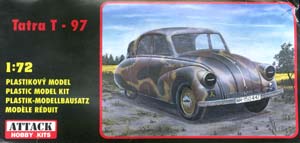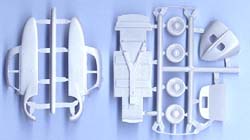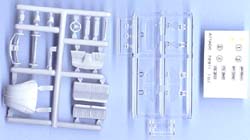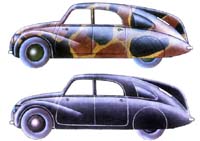Attack Hobby's 1/72 Tatra T-97
By Chris Banyai-Riepl
 |

 |
 The Kit
The Kit The chassis supports the interior as well as provide attachments for the front and rear axles. The interior consists of two bench seats, a front bulkhead with an instrument cluster & separate steering wheel, and a rear bulkhead. These parts fit onto the one-piece chassis, with the axles finding place in front and behind the two bulkheads. The wheels are molded as one piece and fit snugly onto the axles. The engineering makes it easy to assemble and paint, and with the body separate there's no nooks or crannies that are inaccessible after assembly.
The chassis supports the interior as well as provide attachments for the front and rear axles. The interior consists of two bench seats, a front bulkhead with an instrument cluster & separate steering wheel, and a rear bulkhead. These parts fit onto the one-piece chassis, with the axles finding place in front and behind the two bulkheads. The wheels are molded as one piece and fit snugly onto the axles. The engineering makes it easy to assemble and paint, and with the body separate there's no nooks or crannies that are inaccessible after assembly. vehicle from the 3rd Panzer Division, Panzer Regiment HQ in Russia, 1943. This is the same scheme as seen on the boxtop. The second is an overall black vehicle seen in Prague in 1945.
vehicle from the 3rd Panzer Division, Panzer Regiment HQ in Russia, 1943. This is the same scheme as seen on the boxtop. The second is an overall black vehicle seen in Prague in 1945.